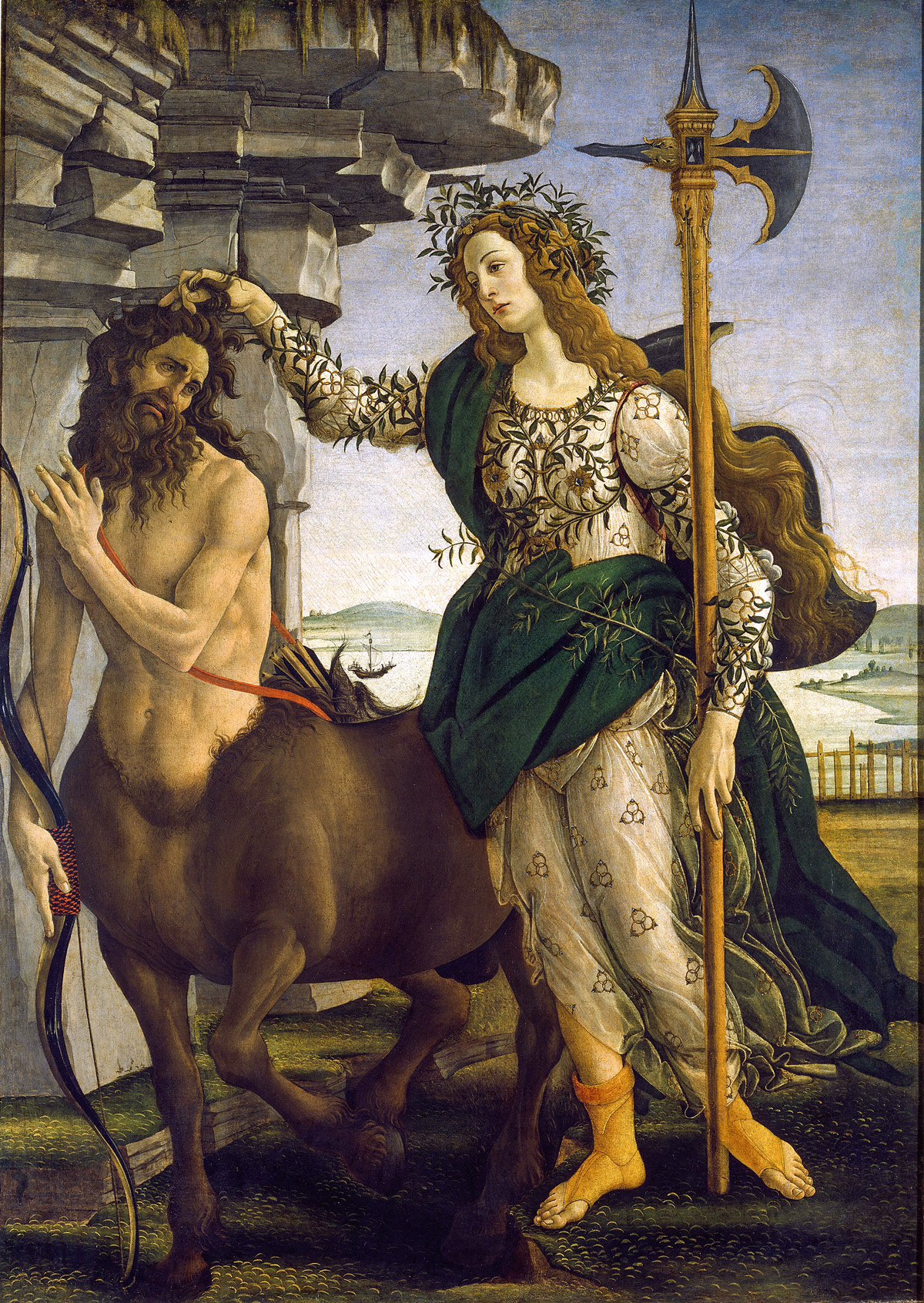Botticelli: A touch of the divine
By Simon Wilson
Published 4 March 2016

Sandro Botticelli, Pallas and the Centaur, c.1482.
© Galleria degli Uffizi, Florence, 2015/Photo Scala, Florence - courtesy of the Ministero
Beni e Att. Cultura.
One of the most fascinating phenomena in the history of art is the
cycle of taste.
Artists ignored in their own time are elevated by later
generations, and artists
who reached a pinnacle of acclaim are thoroughly
buried and then resurrected.
The early Renaissance painter Sandro Botticelli
was famed in 15th-century Florence,
mainly for his (admittedly ravishing)
Madonnas. After his death he was forgotten for
two centuries, and then
underwent an astonishing revival in the 1800s to become one
of the most admired
and best-loved of all Renaissance artists. His Birth of Venus (1482-85)
has a
place in the popular imagination equalled only by the Mona Lisa (c.1503-19),
and frankly is an infinitely more compelling work of art.
The whole extraordinary story is the subject of a major new exhibition
at the V&A,
Botticelli Reimagined, which examines Botticelli himself, the
phenomenon of his
eclipse and revival, and his subsequent increasing grip on
the imagination of both
artists and public. Among his other achievements
Botticelli was the father of
modern, secular book illustration. In the 1480s he
produced an astonishing cycle of
nearly 100 large illustrations, drawn on
vellum in metalpoint and pen and ink, for
Dante’s Divine Comedy. A group of
these is a feature of the V&A exhibition, but
by the wonders of the
zeitgeist the Courtauld Gallery is also showing no less than 30
of them in its
show of treasures from the collection of the 12th Duke of Hamilton.
So why was Botticelli forgotten? One answer is that, together with his
precursors
in the early Renaissance, he was completely overshadowed by the
great triumvirate
of the next generation, Raphael, Michelangelo and Leonardo,
who took naturalism,
the convincing representation of three-dimensional reality
on a two-dimensional surface,
to a new peak of perfection. The earlier artists
were made to look stiff, awkward,
technically unsophisticated and naive in
their simple religious faith. They were
given the pejorative label of
“Primitives”.
And then, how and why was Botticelli resurrected? The idea that
Raphael represented the
absolute pinnacle of art went entirely unchallenged
until, by the mid-1800s, its possibilities
had been so exhausted that artists
started to question the whole premise. Rather gratifyingly,
for readers of RA
Magazine, this revolt – the beginning of what was to become known as
modern art
– had one of its starting points at Burlington House itself, at the 1849 Summer
Show. This was when the 20-year old John Everett Millais (later Sir John, PRA)
exhibited
a painting, Isabella, that in style, spirit and in some specific
details borrowed from Botticelli.
It was signed with the mysterious initials
PRB, for Pre-Raphaelite Brotherhood, and
marked the launch of a hugely
influential movement that explicitly rejected Raphael and
looked instead to the
early Renaissance.
In 1867 another of the original PRB, Rossetti, bought for £20 (about
£2,000 today) a portrait
by Botticelli of a young woman called Smeralda
Bandinelli. Now in the V&A collection,
it lies at the heart of this
exhibition, where its feminist force and luminous beauty offer a
retrospective
rebuke to Leonardo’s similarly posed and sized but simpering and
shadow-shrouded
sitter. It was also at about this time that the railways
reached Florence and a new public
discovered Botticelli’s Venus and Primavera
in the Uffizi. These are not religious paintings,
but highly imaginative pagan
mythologies with love as their true subject. And this, as
Botticelli Reimagined
makes clear, is the real reason for our modern response to him.
The curators of this show have been rather clever in that it tracks
Botticelli’s influence
through the English Pre-Raphaelites and their
Continental Symbolist followers to their
Surrealist and Pop Art successors. We
see these artists reworking the tradition with a vision
that was fresh, highly
imaginative, highly sensuous and often sensual. The exhibition then
finally
gives us Botticelli himself in a climactic selection of about 50 works. The
Birth
of Venus and Primavera can never travel but, among many other goodies, we
have two
of his large-scale masterpieces, the life-size standing Venus (1490), from
Berlin, in which
Botticelli presents the figure from Florence in splendid
solitary grandeur, and Pallas and the
Centaur (c.1482; pictured), his great
mythology, almost equal in its magic and mystery
to Primavera. Its meaning
remains obscure – why, for example, is Pallas entwining
her fingers in the
centaur’s hair? Is she about to kiss him or kill him? Do not miss the
opportunity to see this exhibition and speculate for yourself.
Simon Wilson is an art historian and columnist for RA Magazine.
